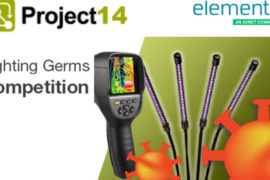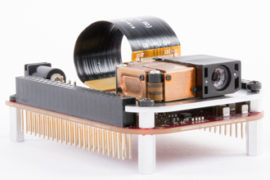Wearable technology is very much in vogue – literally as this story appeared in a recent issue of the renowned fashion magazine – http://www.vogue.co.uk/news/2013/04/24/miss-lady-geek-hosts-wearable-technology-workshop. I’ll admit Disti Blog is unlikely to pop up on the laptop screens of Stella McCartney or Vivienne Westwood read by the Stella McCartney, but element14 just might as it is challenging engineers and developers to design and develop their own piece of wearable technology
The global competition will focus entirely on technology integrated within clothing and wearable accessories, and aims to encourage a deeper level of integration than those demonstrated by first-generation wearables such as the Pebble watch and Google Glass.
Market reports from IHS and Credit Suisse suggest we’ll spend between $6bn and $50bn on wearable technology within five years. Clothing that can recognise and relay the user’s location, environment or status will allow all kinds of new industrial applications or personal well-being solutions.
element14 has selected the Adafruit’s FLORA kit to provide the computing platform for the challenge. The FLORA allows designers to create products that are far more integrated and less expensive and opens up wearable technology to a wider group of users where potential designs could include a tracking device for the elderly or vulnerable, a cycling jacket with built in visibility sensing lights or gloves that operate as hand-worn data terminals. This challenge follows on from element14’s wireless power and energy harvesting challenges, which saw competitors working on projects ranging from monitoring beer brewing to a carbon monoxide detector that never needs batteries.
“Wearable technology is incredibly popular at the moment, from Google Glass to the successful Pebble watch on Kick Starter,” said Dianne Kibbey, Global Head of Community, element14. “Yet we’re still waiting for a product that brings wearable technology together with clothing and that’s what makes this competition and the Adafruit kit stand out. In this challenge we’re calling on our talented community to create something new in wearable technology that will make a difference to the every day lives of the user. From tracking the vulnerable or elderly to finding a lost handbag in a nightclub, wearable technology is only just getting started and has the potential to do so much and this is why we’re all really looking forward to seeing the submissions in this competition.”
The FLORA is the size of a man’s watch face and designed to be literally sewn into an item of clothing or fabric accessory using a special steel wire to run the circuitry within the seams. It is programmed via a built in USB and supports USB HID (human interface device) so it can act like a mouse, keyboard or to attach directly to mobile phones to connect to other users or remote data. The FLORA allows easy control and power of a large quantity of addressable RGB LEDs so all types of displays, effects or indication are possible to provide decoration and functional indication. It is also designed to be robust and as accessible as possible for beginners. The fabric friendly board which weights just 4.4g, has no bare headers which could limit location or damage fabric.
Becky Stern, Director of Wearable Electronics at Adafruit, said: “We’re so excited to see what fun wearable electronics projects the participants make for the challenge, and Adafruit is delighted to work with element14 and its Arduino community to bring us all closer.”
Successful entrants from across the element14 community will be given the chance to build and demonstrate a piece of their own wearable technology which should have a useful impact on everyday lives. element14 is calling for engineers and makers to submit their basic ideas here, from which five will be chosen and given a free FLORA kit to develop their project fully with support from the element14 community and other Arduino developers. The ultimate winner, to be announced in September, will be judged by a panel from Adafruit and the Community on the potential of the prototype to be practical to the point where it can be developed into genuine and mainstream products. The quality of supporting content produced during the course of the competition, including blogs, videos and designs will also be considered in the final judging process.







Comments are closed.